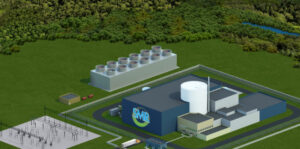By Sheldeen Joy Talavera, Reporter
BUILDING small modular reactors (SMRs) and micro modular reactors (MMRs) will help produce a more “distributed” power generation strategy as opposed to investing in large, expensive facilities, an analyst said.
“If the Philippines adds nuclear power to its supply mix, smaller nuclear plants like SMRs and MMRs should be installed rather than large plants,” Pedro H. Maniego, Jr., senior policy advisor of the Institute for Climate and Sustainable Cities, said via Viber.
SMRs are advanced nuclear reactors of up to 300 megawatts (MW) while MMRs have even smaller footprints better suited for regions with no access to reliable power, according to the International Atomic Energy Agency.
Mr. Maniego said the Philippines should have “distributed generation” rather than a “centralized” system to suit its archipelagic geography.
Last week, the Department of Energy (DoE) and Korea Hydro & Nuclear Power Co., Ltd., signed a memorandum of understanding on energy cooperation, paving the way for a comprehensive technical and economic feasibility study on the potential rehabilitation of the mothballed Bataan Nuclear Power Plant (BNPP).
The feasibility study, which is targeted to commence in January 2025, will be carried out in two phases. The first phase will assess the current condition of the BNPP and its components while the second phase will evaluate whether the plant can be refurbished optimally.
The BNPP, in Morong, Bataan, was completed in 1985, two years behind schedule, according to the Philippine Nuclear Energy Program.
The removal of the first President Marcos from power as well as the Chernobyl nuclear meltdown left the BNPP idle.
The National Power Corp., as designated caretaker of the power plant, placed it in preservation mode.
The DoE aims to have commercially operational nuclear power plants by 2032 with at least 1,200 MW, gradually increasing to 4,800 MW by 2050.
“Pre-development and development of nuclear power plants take time,” Mr. Maniego said. “2032 looks like a reasonable target year to revive the Bataan Nuclear Power Plant if found to be feasible.”
He said, however, that the country could be tapping nuclear power eight years from now.
“The Philippines needs to quickly augment its power supply to meet its rapidly growing needs. We need sufficient and reliable power supply now, not tomorrow,” he said.
Terry L. Ridon, a public investment analyst and convenor of think tank InfraWatch PH, said expectations need to be managed in regard to the BNPP.
“Even if reviving the BNPP on technical grounds is feasible, there will certainly be concerns on how the revival will be funded, either through government or private funds, or a mixture of both,” he said via Viber.
“More importantly, nuclear proponents should provide a clear value proposition for the revival if other types of generating facilities can provide the same amount of electricity but without the political, social and environmental concerns being raised by nuclear opponents,” he added.
